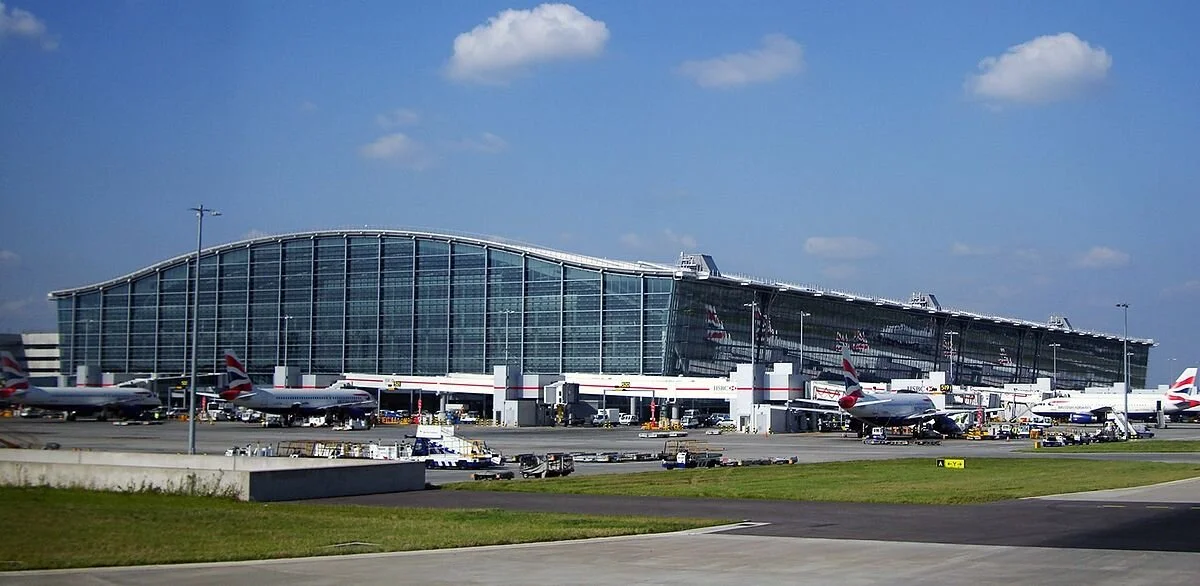How a project to construct a new passenger terminal at Heathrow Airport twenty years ago set the groundwork for a new way to deliver major infrastructure projects in Canada and around the world today.
Heathrow Terminal 5 showed how a radical shift in contracting philosophy can address challenges head-on and lead to successful project delivery. Photo credit: https://www.flickr.com/people/warrenski/
Heathrow Terminal 5
In the 1990s BAA, formerly British Airport Authority, was faced with the monumental task of constructing a new terminal at Heathrow Airport. Terminal 5 was to be built to service 35M passengers and the operations of British Airways. This project would cost nearly $10B CAD (in today’s dollars) and include 3.8M square feet of building area, 60 aircraft stands, 6,000 parking spaces, 9 tunnels, and a massive baggage sorting system – all of which was to be constructed in Europe’s busiest airport.
BAA recognized that a project of this scale and complexity would require a unique contracting approach. When this project was first being developed, the use of Public-Private Partnerships (PPPs, also known as PFI in the UK) to build infrastructure was gaining momentum in the UK. However, in preparing for the Heathrow Terminal 5 project, the BAA conducted a case study review of every UK construction project over £1B in the 10 years prior and all international airports that had opened in the past 15 years. This review indicated to BAA that the poor performance of past projects was associated with fixed price contracting and a large degree of risk transfer to the private sector – fundamental components of PPP contracting. Instead, BAA adopted elements of a contracting strategy that had recently been promoted in the UK Oil and Gas Industry where no fixed price is employed and the agreement is based on principles of cooperation between the owner and constructor.
The contracting strategy employed by BAA for the Heathrow Terminal 5 project was a form of relational contracting. A delivery partner was selected based on its ability to provide skilled people with the knowledge and experience necessary to successfully deliver the project. Suppliers were paid based on their actual costs and incentivized with performance bonuses for performing better than target. The intent of this model was that risks would be managed collaboratively as they materialized and the scope would be somewhat flexible to accommodate changes as the design was developed. The flexibility of the model also allowed for a more collaborative and iterative approach to design that helped to support project innovation.
“BAA’s initial case study review found that none of the UK construction projects it reviewed were built on time, on schedule and to the required quality standards. In contrast, Heathrow Terminal 5 was built on time and on schedule.”
BAA’s initial case study review found that none of the UK construction projects it reviewed were built on time, on schedule and to the required quality standards. In contrast, Heathrow Terminal 5 was built on time and on schedule. All of the international airports BAA reviewed experienced performance issues on opening. Heathrow Terminal 5 experienced a similar fate suffering from a baggage handling failure on opening day. Nonetheless, Heathrow Terminal 5 demonstrated how a large and complex megaproject could perform as well or better than past projects using a flexible contracting approach that focused on the proactive management of risks and recovery after the occurrence of risk.
Major Project Delivery in Canada
Major infrastructure project delivery around the world has long faced the same types of challenges that BAA faced in planning the Heathrow Terminal 5 project. The budget and schedule overruns of major infrastructure projects have been well documented by researchers. Thinking about the Canadian context, the Toronto York Subway Extension, the Vancouver Convention Centre and the Muskrat Falls Dam come to mind as projects that have failed to meet targets. In Canada (and elsewhere around the world) the PPP model has been employed to vastly improve budget and schedule performance. However, various Auditor Generals across the country have highlighted real and perceived challenges of the model (e.g. British Columbia, Ontario, Nova Scotia).
Procurement agencies across the country have responded to criticism of the Public-Private Partnership model with incremental improvements that largely keep the fundamental principles of P3 contracting intact. However, two recent market shifts have precipitated the need for a more fundamental change to the delivery of major infrastructure projects in Canada.
First, in 2018 Carillion collapsed in the UK. Carillion was a constructor and facilities operator that had been involved in the delivery of many of the UK’s PFI (PPP) contracts. Inquests into the collapse of Carillion have suggested that underbidding and inappropriate risk transfer contributed to the company’s collapse. The infrastructure market has responded to this collapse with a reduced appetite to bid on risky fixed price PPP contracts. This has been felt in Canada, too, with contractors pushing back against risk transfer, and SNC Lavalin’s recent move away from lump sum turnkey projects.
Second, the initial wave of PPP contracts in Canada were focused on vertical social infrastructure such as hospitals and courthouses. Increasingly, a new wave of transit projects is emerging, including more than $35B of transit projects in Ontario. The scale and complexity of these projects presents a new level of project risk, especially as it relates to utilities, properties and unknown ground conditions. The private sector has reacted by seeking new approaches to risk transfer/sharing and for the public sector to take back some of the risk that was previously transferred.
Alliance Contracting
In an effort to address the complexity of major infrastructure projects and the present (low) appetite of the private sector to accept risk, provincial governments in Canada have begun leveraging a contracting model that evolved from Heathrow Airport Terminal 5, and the UK oil and gas projects of the 1990s. The Alliance Contracting Model is being developed for use in British Columbia and in late 2019, the first Alliance procurement was announced by Metrolinx and Infrastructure Ontario for the Union Station Enhancement Project. This model closely resembles the contracting methodology developed to deliver Heathrow Terminal 5.
The provincial government in Ontario is beginning to look to Alliance Contracting to solve their project delivery challenges related to the current pipeline of large rail and transit projects. Photo credit: Michael Himmel.
Under the Alliance Model, a private sector partner is selected based on an assessment of the quality of its team, experience and partnering approach. No firm fixed price is established at any point, and generally there is no discussion of pricing in the partner selection process.
The infrastructure owner and the private sector partner aim to work collaboratively to develop the specifications, design the desired infrastructure and then undertake to construct it. Direct costs (ie. salaries and benefits, materials) are paid as they are incurred. Typically, a target price is agreed to during the design stage and profits are only paid according to the overall project organization’s performance against the target price. If the target price is exceeded, then profit will be reduced. However, the private sector partner’s direct costs are always covered. This approach to payment incentivizes high performance while protecting the contractor from significant losses if risks materialize. It also simplifies project delivery as individual risks do not need to be apportioned and disputed. The intent is to incentivize the owner and the delivery partner to work through issues, minimize costs and complete the project.
“The Alliance Model endeavours to promote a collaborative working relationship between the owner and delivery partner and minimize disputes.”
The Alliance Model endeavours to promote a collaborative working relationship between the owner and delivery partner and minimize disputes. A board with representatives from the owner’s side and the private partner’s side is empowered to govern the project and make decisions. Management of the project occurs through an integrated team comprised of both owner and delivery partner participants. Early on the project organization establishes a set of Alliance Principles that participants must abide by, generally including concepts such as a no-blame culture, fully open-book transactions, equitable sharing of risk and reward, and a focus on best-for-project decision-making. An extremely practical, but perhaps emblematic, difference from traditional contracting is the co-location of the entire project team (owner and delivery partner participants) in a single physical space to encourage working through issues before they escalate.
Looking Ahead
When BAA was developing its delivery model for Heathrow Terminal 5 – what would eventually evolve into today’s Alliance Contracting – it was trying to develop a workable solution to deliver a large, complex and risky project. In Canada today, public infrastructure delivery is grappling with the same challenges. The market has shown an uneasiness with the level of risk involved in the delivery of large fixed price contracts. And this problem is compounded by the size and complexity of the project pipeline in Canada today. Especially for those projects with challenging interface issues and difficult-to-define risks (ie. Union Station Enhancement Project). Heathrow Terminal 5 showed how a radical shift in contracting philosophy can address these exact challenges head-on and lead to successful project delivery. The current infrastructure landscape is forcing infrastructure owners and delivery agencies to rethink their business, and Alliance contracting may be the solution that is needed for certain risky and complex projects.
By Michael Himmel, Senior Associate at Access



